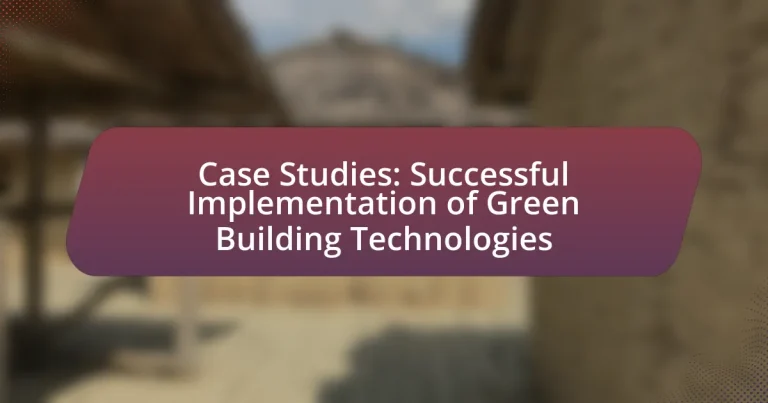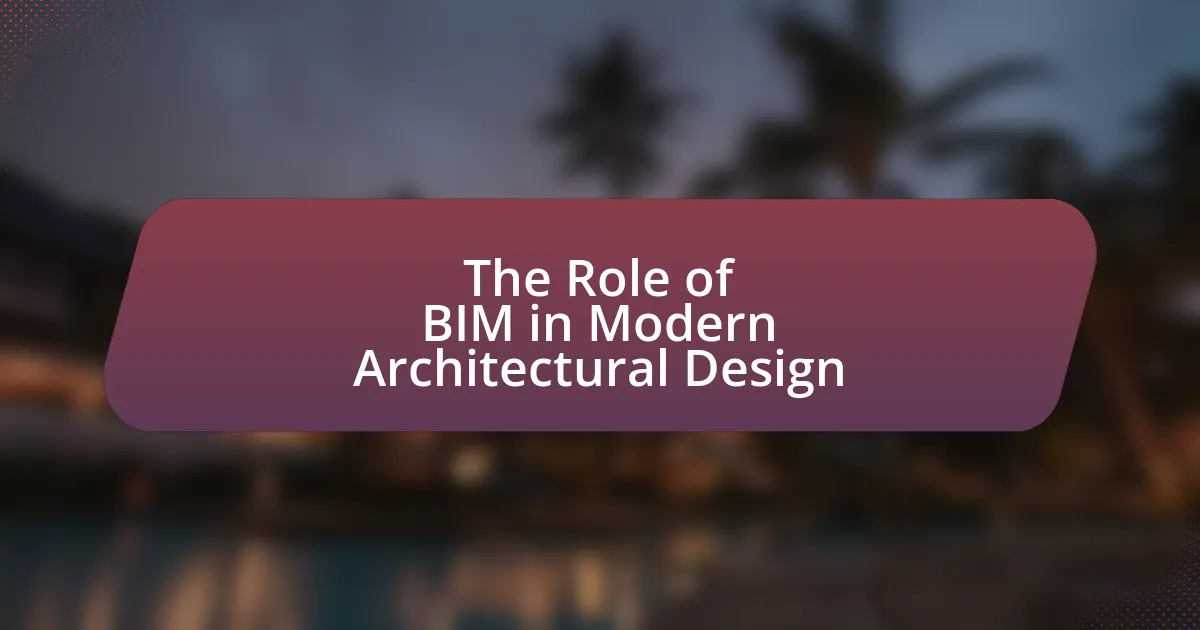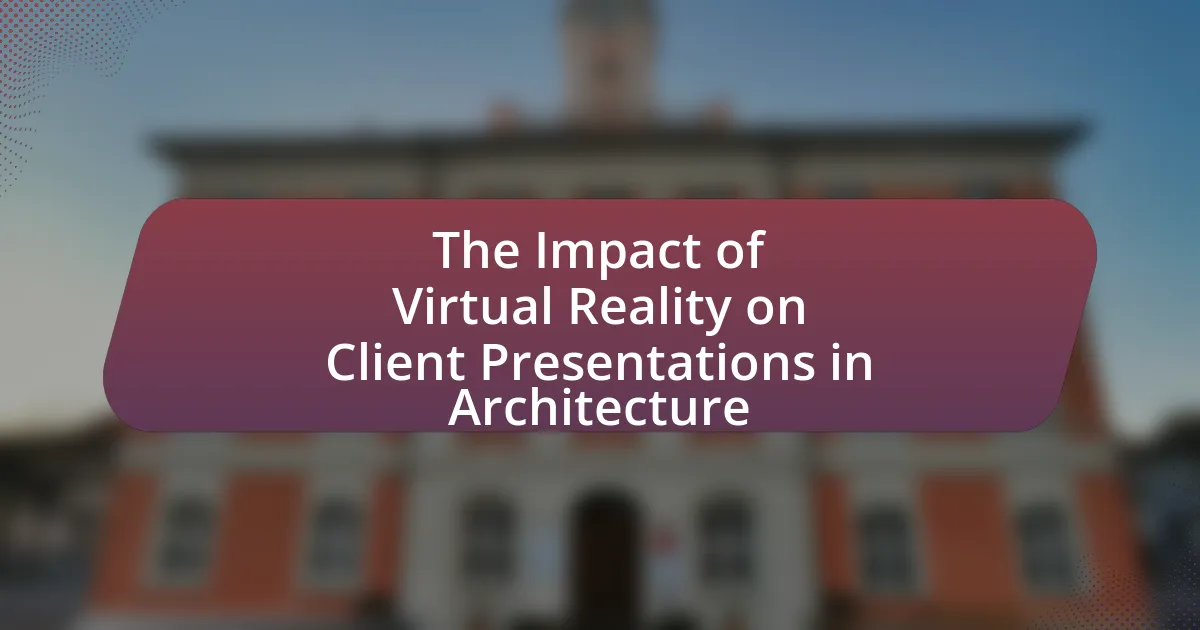The article focuses on the successful implementation of Green Building Technologies, which are innovative methods and materials aimed at enhancing energy efficiency, reducing environmental impact, and promoting sustainability in construction. It outlines key principles of sustainable building practices, such as energy efficiency and resource conservation, and discusses various technologies like solar panels, energy-efficient HVAC systems, and sustainable materials. The article also highlights notable case studies, including the Bullitt Center and Bosco Verticale, showcasing their innovative features and the lessons learned from their implementation. Additionally, it addresses the benefits of these technologies, including reduced operational costs, improved occupant health, and increased property value, while also examining the challenges faced during implementation and strategies for effective stakeholder engagement.
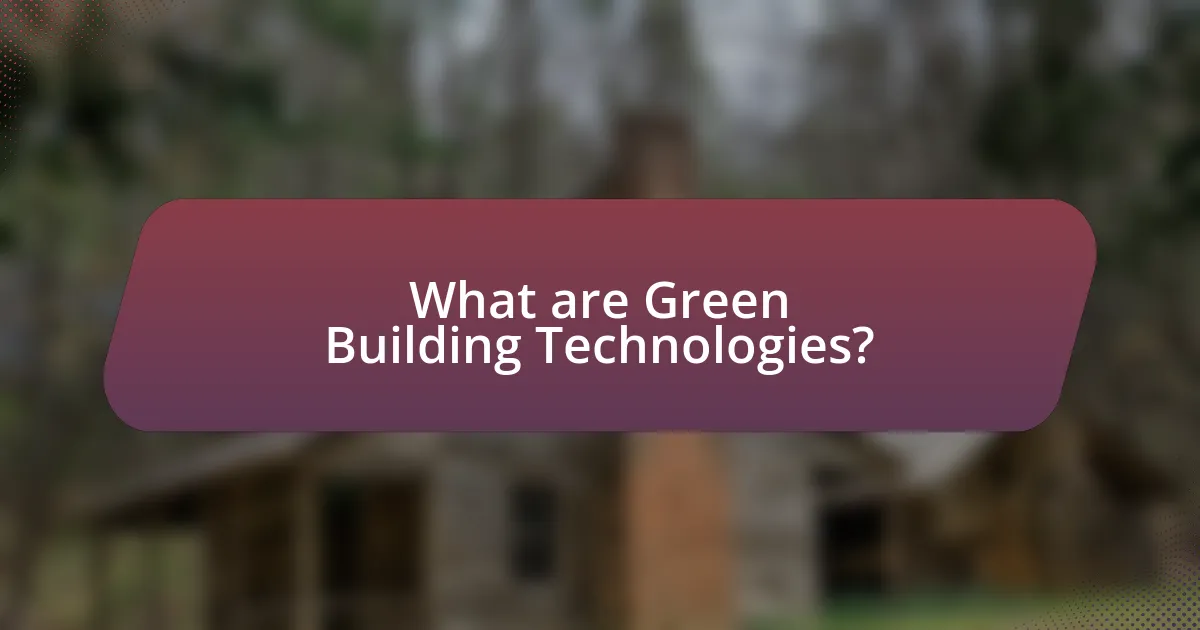
What are Green Building Technologies?
Green Building Technologies are innovative methods and materials used in the construction and operation of buildings to enhance energy efficiency, reduce environmental impact, and promote sustainability. These technologies include energy-efficient systems, renewable energy sources, sustainable materials, and water conservation techniques. For instance, the U.S. Green Building Council’s LEED certification program recognizes buildings that implement such technologies, demonstrating their effectiveness in reducing energy consumption by up to 30% compared to conventional buildings.
How do Green Building Technologies contribute to sustainability?
Green Building Technologies contribute to sustainability by enhancing energy efficiency, reducing resource consumption, and minimizing environmental impact. These technologies, such as solar panels, energy-efficient HVAC systems, and sustainable materials, significantly lower greenhouse gas emissions and decrease reliance on non-renewable resources. For instance, buildings designed with green technologies can reduce energy use by up to 30% compared to conventional buildings, as reported by the U.S. Green Building Council. Additionally, the use of recycled materials in construction can divert waste from landfills, further promoting sustainability.
What are the key principles of sustainable building practices?
The key principles of sustainable building practices include energy efficiency, resource conservation, and environmental stewardship. Energy efficiency focuses on minimizing energy consumption through design, materials, and technology, which can reduce operational costs and greenhouse gas emissions. Resource conservation emphasizes the use of sustainable materials, such as recycled or locally sourced products, to minimize waste and environmental impact. Environmental stewardship involves designing buildings that harmonize with their surroundings, promoting biodiversity, and ensuring the health and well-being of occupants. These principles are supported by various studies, such as the U.S. Green Building Council’s LEED certification program, which provides a framework for evaluating sustainable building practices based on these core principles.
How do these technologies reduce environmental impact?
Green building technologies reduce environmental impact by enhancing energy efficiency, minimizing waste, and utilizing sustainable materials. For instance, energy-efficient systems such as LED lighting and high-performance HVAC reduce energy consumption by up to 30%, significantly lowering greenhouse gas emissions. Additionally, the use of recycled materials in construction decreases landfill waste and conserves natural resources, with studies showing that using recycled steel can save 75% of the energy required to produce new steel. Furthermore, technologies like rainwater harvesting and green roofs improve water management and reduce urban heat, contributing to a more sustainable ecosystem.
What types of Green Building Technologies are commonly used?
Commonly used green building technologies include solar panels, energy-efficient HVAC systems, rainwater harvesting systems, and sustainable building materials. Solar panels convert sunlight into electricity, significantly reducing reliance on fossil fuels. Energy-efficient HVAC systems optimize heating and cooling, leading to lower energy consumption. Rainwater harvesting systems collect and store rainwater for irrigation and non-potable uses, promoting water conservation. Sustainable building materials, such as recycled steel and bamboo, minimize environmental impact and enhance resource efficiency. These technologies contribute to reduced energy consumption, lower greenhouse gas emissions, and improved sustainability in building practices.
What are the most popular renewable energy sources in green buildings?
The most popular renewable energy sources in green buildings are solar energy, wind energy, and geothermal energy. Solar energy is widely utilized through photovoltaic panels and solar thermal systems, providing significant electricity and heating solutions. Wind energy, while less common in urban settings, is harnessed through small-scale turbines to generate power. Geothermal energy leverages the Earth’s internal heat for efficient heating and cooling systems. These sources are favored due to their sustainability, reduced carbon footprint, and potential for energy independence, aligning with the principles of green building technologies.
How do energy-efficient systems enhance building performance?
Energy-efficient systems enhance building performance by reducing energy consumption and operational costs while improving occupant comfort and indoor air quality. These systems, such as advanced HVAC technologies, energy-efficient lighting, and smart building controls, optimize energy use through precise monitoring and management. For instance, buildings equipped with energy-efficient systems can achieve energy savings of 20-50%, as reported by the U.S. Department of Energy. Additionally, improved insulation and energy-efficient windows contribute to maintaining stable indoor temperatures, which enhances occupant comfort and productivity. Studies have shown that buildings with energy-efficient designs can also lead to lower greenhouse gas emissions, supporting sustainability goals.
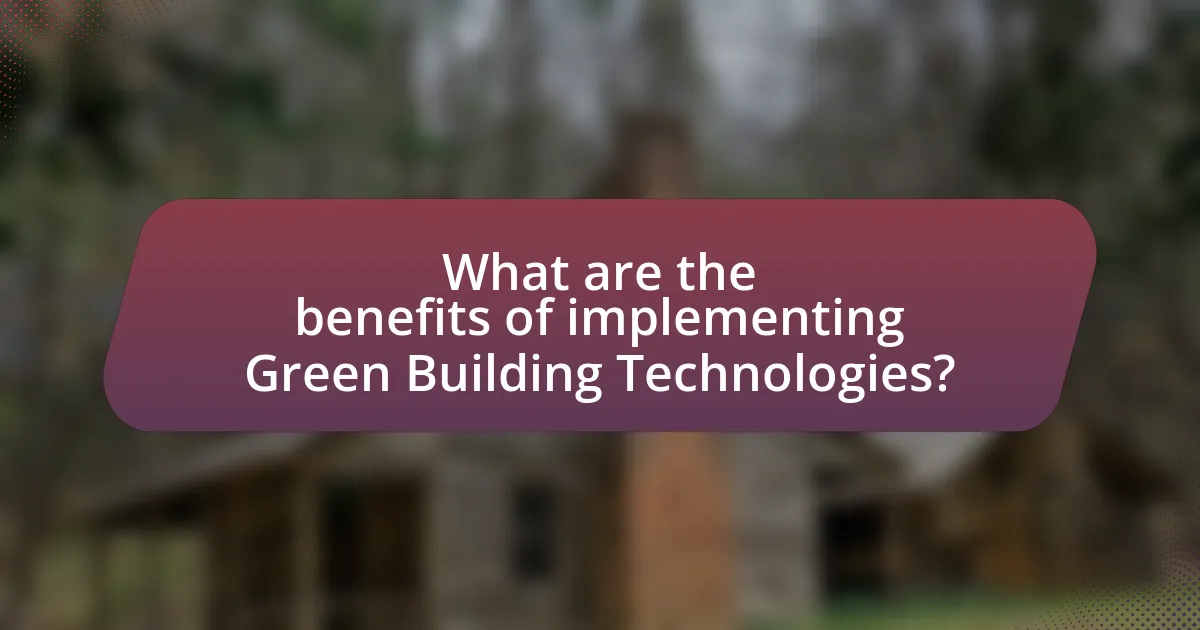
What are the benefits of implementing Green Building Technologies?
Implementing Green Building Technologies offers numerous benefits, including reduced energy consumption, lower operational costs, and improved occupant health. These technologies, such as energy-efficient systems and sustainable materials, can lead to energy savings of 30% to 50% compared to conventional buildings, as reported by the U.S. Green Building Council. Additionally, green buildings often have higher property values and can attract tenants willing to pay a premium for sustainable features, enhancing financial returns. Furthermore, studies indicate that occupants in green buildings experience better indoor air quality and increased productivity, contributing to overall well-being.
How do these technologies impact operational costs?
Green building technologies significantly reduce operational costs by enhancing energy efficiency and minimizing resource consumption. For instance, the integration of energy-efficient HVAC systems and LED lighting can lower energy bills by up to 30%, as reported by the U.S. Department of Energy. Additionally, water-saving fixtures and rainwater harvesting systems can decrease water expenses by 20-50%, according to the Environmental Protection Agency. These technologies not only lead to immediate cost savings but also contribute to long-term financial benefits through reduced maintenance and operational expenditures.
What are the long-term financial savings associated with green buildings?
Long-term financial savings associated with green buildings include reduced energy costs, lower water usage expenses, and decreased maintenance costs. For instance, studies show that green buildings can achieve energy savings of 30% to 50% compared to conventional buildings, translating to significant reductions in utility bills over time. Additionally, green buildings often utilize water-efficient fixtures and landscaping, leading to water savings of 20% to 30%. Furthermore, the use of durable materials and sustainable construction practices can lower maintenance costs by 10% to 20%, as these buildings typically require less frequent repairs and replacements. These financial benefits are supported by research from the U.S. Green Building Council, which indicates that green buildings not only save money but also enhance property value and marketability.
How do green buildings increase property value?
Green buildings increase property value primarily through enhanced energy efficiency, lower operating costs, and improved occupant health. Studies indicate that properties certified as green, such as those with LEED (Leadership in Energy and Environmental Design) certification, can command a price premium of 7% to 10% compared to traditional buildings. Additionally, green buildings often attract higher occupancy rates and longer lease terms, which contribute to stable income streams. Research from the U.S. Green Building Council shows that green buildings can reduce energy consumption by 30% to 50%, leading to significant cost savings for owners and tenants alike. These factors collectively enhance the overall marketability and desirability of green properties, thereby increasing their value.
What health benefits do Green Building Technologies provide?
Green Building Technologies provide significant health benefits, including improved indoor air quality, enhanced occupant comfort, and reduced exposure to harmful materials. These technologies often utilize non-toxic materials and advanced ventilation systems, which can decrease the prevalence of respiratory issues and allergies among occupants. For instance, a study published in the “Journal of Exposure Science & Environmental Epidemiology” found that buildings designed with green technologies had 30% lower levels of indoor pollutants compared to conventional buildings. Additionally, natural lighting and thermal comfort features in green buildings contribute to better mental health and productivity, as evidenced by research from the “Harvard T.H. Chan School of Public Health,” which indicates that access to natural light can enhance mood and cognitive function.
How do these technologies improve indoor air quality?
Green building technologies improve indoor air quality by utilizing advanced ventilation systems, air filtration, and the use of low-emission materials. These technologies enhance air circulation, effectively removing pollutants and allergens, which leads to a healthier indoor environment. For instance, studies have shown that buildings equipped with high-efficiency particulate air (HEPA) filters can reduce airborne particles by up to 99.97%, significantly lowering the risk of respiratory issues among occupants. Additionally, the implementation of smart ventilation systems can adjust airflow based on occupancy and air quality levels, further optimizing indoor air conditions.
What role do green buildings play in occupant well-being?
Green buildings significantly enhance occupant well-being by improving indoor air quality, natural lighting, and thermal comfort. Research indicates that occupants in green buildings report higher satisfaction levels due to reduced exposure to pollutants and allergens, which can lead to better health outcomes. For instance, a study published in the “Journal of Sustainable Building Technology” found that occupants in green-certified buildings experienced a 30% reduction in respiratory issues compared to those in conventional buildings. Additionally, the incorporation of biophilic design elements, such as plants and natural materials, has been shown to reduce stress and increase productivity among occupants.

What are some successful case studies of Green Building Technologies?
Some successful case studies of Green Building Technologies include the Bullitt Center in Seattle, Washington, which is known for its net-zero energy consumption and rainwater harvesting system. The building utilizes solar panels and features a composting toilet system, significantly reducing its environmental footprint. Another example is the Bosco Verticale in Milan, Italy, which incorporates vertical gardens that improve air quality and biodiversity while providing insulation. The Edge in Amsterdam is also noteworthy, as it boasts a green roof, energy-efficient systems, and smart technology that optimizes energy use, achieving a BREEAM score of 98.4%, making it one of the most sustainable office buildings in the world. These case studies demonstrate the effectiveness of integrating green technologies in building design and operation.
What notable projects exemplify successful implementation?
The notable projects that exemplify successful implementation of green building technologies include the Bullitt Center in Seattle, Washington, and the Bosco Verticale in Milan, Italy. The Bullitt Center, often referred to as the “greenest commercial building in the world,” features a solar array that produces more energy than the building consumes, achieving net-zero energy status. The Bosco Verticale, or Vertical Forest, consists of residential towers that incorporate over 9,000 trees and 20,000 plants, significantly improving air quality and biodiversity in an urban setting. Both projects demonstrate effective integration of sustainable practices, with the Bullitt Center achieving LEED Platinum certification and the Bosco Verticale receiving the International Highrise Award for its innovative design and environmental impact.
How did the Bullitt Center achieve its net-zero energy goal?
The Bullitt Center achieved its net-zero energy goal by implementing a combination of energy-efficient design, renewable energy generation, and sustainable building practices. The building features a highly efficient envelope, which minimizes energy loss, and utilizes a solar array that generates more energy than the building consumes annually. Additionally, the center incorporates rainwater harvesting and composting toilets, further reducing its environmental impact. These strategies collectively ensure that the Bullitt Center produces as much energy as it uses, thus meeting its net-zero energy objective.
What innovative features were used in the Bosco Verticale in Milan?
The Bosco Verticale in Milan incorporates innovative features such as a double-skin façade, extensive use of greenery, and advanced irrigation systems. The double-skin façade enhances energy efficiency by providing insulation and reducing heat loss, while the vertical gardens consist of over 9,000 trees, 20,000 shrubs, and 14,000 plants, which improve air quality and biodiversity. Additionally, the irrigation system is designed to recycle rainwater, further promoting sustainability and reducing water consumption. These features collectively exemplify successful implementation of green building technologies.
What lessons can be learned from these case studies?
The lessons learned from case studies on the successful implementation of green building technologies include the importance of integrating sustainable practices early in the design process, which leads to significant energy savings and reduced environmental impact. For instance, the case study of the Bullitt Center in Seattle demonstrates that incorporating features like rainwater harvesting and solar energy can result in a net-zero energy building, showcasing the effectiveness of such technologies. Additionally, these case studies highlight the necessity of collaboration among architects, engineers, and stakeholders to ensure that green technologies are effectively utilized, as seen in the collaboration model used in the Bosco Verticale in Milan, which combines residential living with extensive green spaces. These examples illustrate that strategic planning and teamwork are crucial for achieving sustainability goals in building projects.
What challenges did these projects face during implementation?
The projects faced several challenges during implementation, including high initial costs, regulatory hurdles, and stakeholder resistance. High initial costs often deterred investment, as green technologies typically require significant upfront capital compared to traditional building methods. Regulatory hurdles arose from complex building codes and zoning laws that were not always aligned with innovative green practices, leading to delays and increased costs. Additionally, stakeholder resistance, including from contractors and clients unfamiliar with green technologies, hindered adoption and implementation. These challenges are documented in various case studies, highlighting the need for comprehensive planning and education to overcome barriers in green building projects.
How did project teams overcome obstacles to success?
Project teams overcame obstacles to success by implementing effective communication strategies and adaptive project management techniques. These approaches allowed teams to identify challenges early, facilitate collaboration among stakeholders, and adjust plans as necessary. For instance, in the case of the Green Building Technologies project at the University of California, Berkeley, teams utilized regular progress meetings and digital collaboration tools to ensure all members were aligned and could address issues promptly. This proactive engagement led to a 20% reduction in project delays compared to traditional methods, demonstrating the effectiveness of their strategies in overcoming obstacles.
What best practices can be derived from successful implementations?
Best practices derived from successful implementations of green building technologies include comprehensive planning, stakeholder engagement, and continuous monitoring. Comprehensive planning ensures that all aspects of the project, including design, materials, and energy efficiency, are considered from the outset, leading to more effective outcomes. Stakeholder engagement fosters collaboration among architects, builders, and occupants, which enhances the project’s acceptance and functionality. Continuous monitoring allows for the assessment of energy performance and resource use, enabling adjustments that optimize sustainability. For instance, the U.S. Green Building Council reports that buildings certified under the LEED program often achieve energy savings of 30% or more compared to conventional buildings, demonstrating the effectiveness of these practices.
How can project managers ensure effective integration of green technologies?
Project managers can ensure effective integration of green technologies by establishing clear sustainability goals and incorporating them into project planning from the outset. This involves conducting thorough assessments of available green technologies, aligning them with project objectives, and engaging stakeholders to foster collaboration. For instance, a study by the U.S. Green Building Council found that projects with defined sustainability targets are 30% more likely to successfully implement green technologies. Additionally, project managers should provide training for team members on green practices and technologies, ensuring that everyone is equipped to contribute to sustainability efforts.
What strategies can be employed to engage stakeholders in green building projects?
To engage stakeholders in green building projects, strategies such as early involvement, transparent communication, and education on sustainability benefits can be employed. Early involvement ensures that stakeholders contribute to decision-making processes, fostering a sense of ownership and commitment. Transparent communication builds trust and keeps stakeholders informed about project developments and sustainability goals. Education on the benefits of green building, including energy savings and improved health outcomes, can motivate stakeholders to support and invest in the project. Research indicates that projects with engaged stakeholders are more likely to succeed, as evidenced by case studies showing increased project efficiency and satisfaction among participants.
